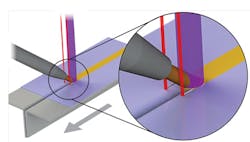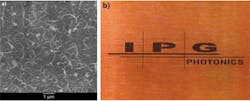Fiber Lasers: Multiple laser beam materials processing
TOBY STRITE, ANDREAS GUSENKO, MICHAEL GRUPP, and TONY HOULT
Manufacturers view laser material processing as a mature, well-understood productivity enhancement, which they constantly seek to extend to new segments of their business. Lately, that search has produced a trend toward the deployment of multiple laser beams on a single workpiece, each optimized to perform a facet of the overall process. This trend is already undergoing rapid adoption in automotive manufacturing, and we believe it will soon impact other fields.
This article highlights three examples of multiple laser beam processing. To begin, we show how trifocal brazing utilizes coordinated beams to join automotive materials with high strength and superior cosmetics. Next, we examine the benefits of a two-step welding process for high-strength steel, in which a laser cleaning step enables laser welds of outstanding strength and integrity. Our final example highlights how laser surface texturing of a metal enables high-strength, hermetic polymer-to-metal bonding. These examples highlight the possibilities available when multiple laser beams of differing diameter, pulse durations, or even wavelength are coordinated to produce previously unobtainable results.
Trifocal brazing
The automobile industry relies of the unique ability of lasers to provide high joint strength with minimum material usage, at the same time promoting safety and fuel economy. While laser welding is entrenched within the automobile, a more cosmetic process is preferred in visible joints along the roofline and car sides. In contrast to welding, brazing is a technique that does not melt the surfaces to be joined. Rather, for automotive applications, laser energy melts a wire to form a cohesive joint between two steel or aluminum surfaces. Automakers desire a brazing process that requires just a light brushing prior to the application of paint to realize a truly seamless joint.
Brazing studies on electro-galvanized low-carbon steel link joint quality and aesthetics to edge variability. In particular, oxides and contaminants residing on the thin zinc (Zn) anti-scaling layer are the main causes of spatter and edge roughness. This knowledge inspired the development of a novel three-beam brazing system in which two lead beams travel along the steel edges ablate contaminants and pre-heat the Zn surface layer to promote wetting. The powerful trailing beam supplies energy to melt the Cu/Si wire to seamlessly join the newly cleaned steel surfaces (see Fig. 1).
The trifocal brazing system relies on the flexibility of fiber technology (see Fig. 2). Fiber lasers are coupled into three optical fibers of different diameter, which are delivered through a single cable. Near the workpiece, the delivery optic creates the desired three-beam profile, allowing the narrow lead beams to pre-clean before the trailing beam completes the spatter-free brazed seam.Trifocal brazing combines cleaning and joining in a single process, greatly reducing post-processing requirements before painting. The brazing can be fully automated at high speed with excellent joint strength and reproducibility along straight and curved borders. Automakers are increasingly adopting trifocal brazing as their preferred solution for cosmetic steel joints to optimize both productivity and aesthetics.
Two-step laser welding of high-strength steel
Automakers constantly seek materials and joining methods that enable safer and more efficient vehicles. High-strength steels (HSS) bolstered by the element boron have moved to the forefront of automotive innovation, offering strength levels so great that the Jaws of Life auto rescue tool had to be re-specified in North America. Higher strength presents the opportunity to use less material for reduced vehicle weight, assuming joining technology can keep pace. Laser welding is automakers' preferred method for joining HSS. Early efforts were hampered by the aluminum silicon (AlSi) protective coatings added to avoid scaling during the hot stamping process. Brittle iron aluminum (FeAl) inter-metallic layers may result when AlSi-coated HSS is laser-welded.
Outstanding HSS weld quality is achievable when the anti-scaling coating on either side of the weld region is laser-ablated, enabling a weld between identical, clean steel surfaces free of FeAl inter-metallics. Figure 4 illustrates a clean steel surface prepared by laser ablation on which the AlSi coating is fully removed by a 1 kW, 70 ns NIR pulsed fiber laser. The ablation laser provides up to 100 mJ pulse energy (7–10 J/cm2 fluence over a 1 mm2 spot) delivered through a novel square process fiber to perform a precise and economical 10 m/min ablation of a 30 μm AlSi coating. Subsequent high speed welding using a multi-kilowatt continuous-wave (CW) NIR fiber laser completes the joining process, allowing strong but lightweight tailor-welded blanks to be supplied to the auto industry.In contrast to trifocal brazing, which employs two CW laser beams of different diameter, two-step welding of HSS is optimized by first applying a high-energy pulsed nanosecond ablation laser, followed by a high-power CW welding laser. Our final example also utilizes a pulsed/CW laser one-two punch, but we extend into the sub-nanosecond pulsed regime and apply two different laser wavelengths.
Polymer-to-metal joining
Welding requires melting of opposing surfaces to fuse the materials into a robust joint. Welding is widely used to join metals to metals, or polymers to polymers. However, disparate melting temperatures largely rule out polymer-to-metal welding. Effective polymer-to-metal joining remains a highly sought technology for industries as diverse as consumer electronics and medical devices. A recently developed two-step process relying on new fiber laser technology provides a promising solution.
The first step relies on a 30 W NIR fiber laser capable of 400 kW peak power when pulsed at 150 ps to provide a novel metal surface texture (see Fig. 5a). Microscopic studies suggest the high laser fluence melts a nanometer-scale surface layer, which coalesces quickly into a fine, nodular structure, one whose large surface area is ideal for subsequent adhesive bonding.What is remarkable about these textured surfaces is that they can be made perfectly black, even on highly reflective metals like Cu (see Fig. 5b). Experienced welders know that a uniformly dark surface provides the widest process window since reflectivity variations affect the threshold energy that a laser must supply to couple into a reflective metal.
Polymer-to-metal joining relies on the 1.9 μm lasing wavelength of thulium-doped CW fiber lasers. The mid-infrared wavelength is more strongly absorbed by common transparent polymers than NIR fiber laser or laser diode sources. Conventional 1 μm lasers pass through the polymer, heating only the opposing metal surface. This conducts heat into the polymer, eventually melting it into the metal to form a weak bond.
We find that polymer-to-metal bond strength is remarkably improved by first texturing and darkening the metal surface, then applying thermal energy using the 1.9 μm fiber laser. The longer wavelength transfers heat directly to the polymer as well as the polymer-to-metal interface. The direct heating of the polymer, combined with the dark nodular metal surface, provides ideal bonding conditions. We have formed polymer-to-titanium bonds that are hermetic and so strong that they fail in the polymer when subjected to shear force.
In contrast, when the surface texturing step is omitted, lap shear tests fail at the polymer-to-metal interface, attesting to a weaker bond. Robust, hermetic joining of transparent polymers to metals opens a new degree of design and manufacturing freedom that has already generated interest among customers in fields as diverse as medical devices, consumer electronics, and low-cost consumer products.
Toby Strite is director of Western U.S. sales, marketing, and applications at IPG Photonics, Santa Clara, CA; Andreas Gusenko is a product engineer specializing in automotive applications at IPG Photonics, Burbach, Germany; Michael Grupp is applications manager at IPG Photonics, Burbach, Germany; and Tony Hoult is applications manager at IPG Photonics, Santa Clara, CA; e-mail: [email protected]; www.ipgphotonics.com.




